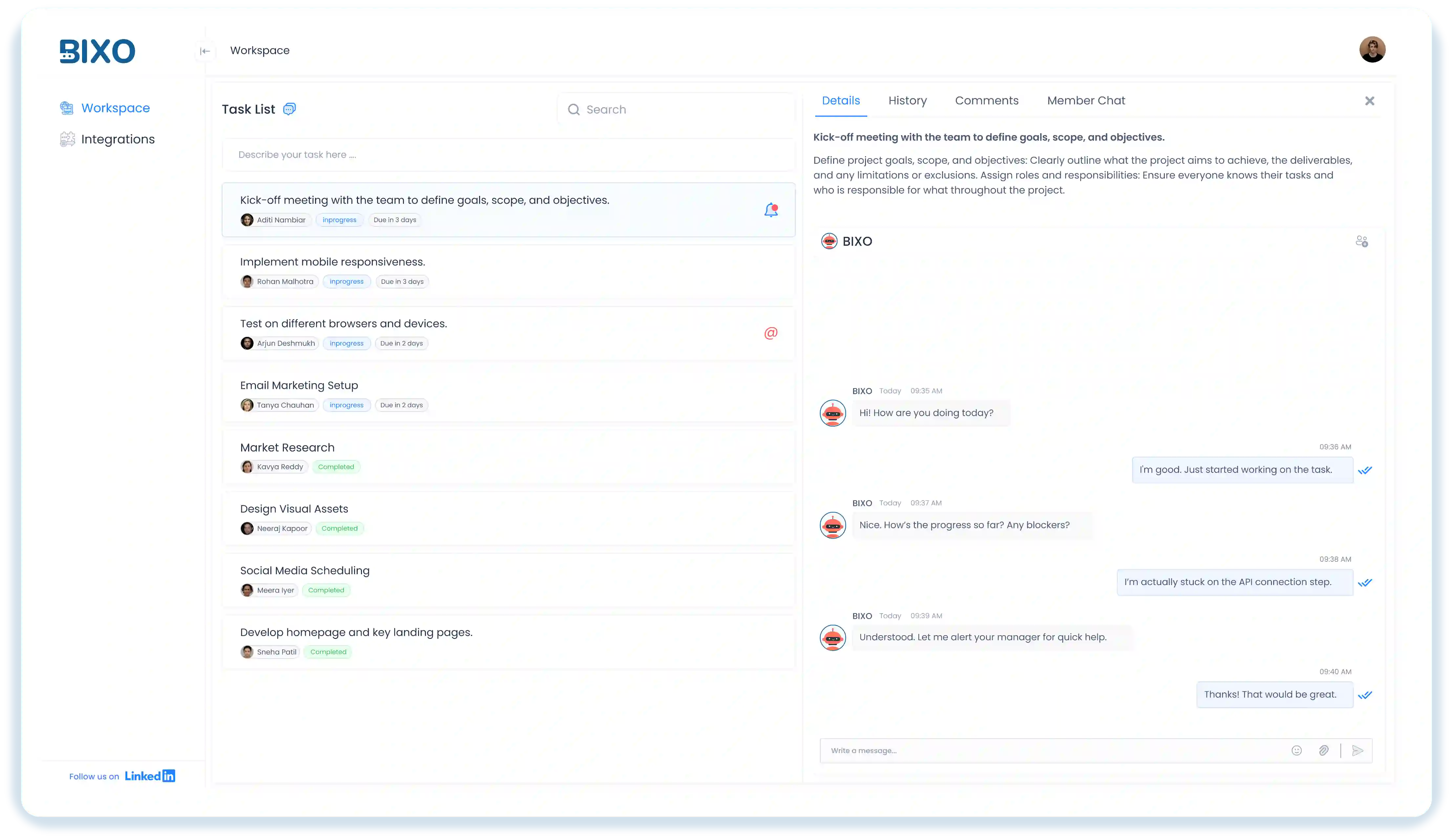
Table of Content
Focus on what matters. BIXO handles the rest!

Imagine you are planning a large project. At first, everything seems perfect, but then unexpected issues arise, such as budget reductions, last-minute delays, or technical malfunctions. These risks can affect your confidence and slow down progress. This is the reason the risk management process is so important in your project. Instead of letting these risks interrupt your progress, this process gives you a clear way to prepare.
By following the five steps of the risk management process, you can predict challenges, give smart responses and ensure your project is moving toward success. In this guide, you will learn how risk management works and how you can use these steps to stay in control at every stage.
What Is the Risk Management Process?
The risk management process is a step-by-step method that assists you in dealing with uncertainty in projects or business operations. Instead of waiting for issues to show up, this process helps you identify the risks early, research how they impact, and decide the best way to deal with problems.
Knowing the risk management process will help you make smarter decisions and keep your work on track. It is not about eliminating any risks but ensuring that risks do not control your project. You can stay strong in advance by spotting what might go wrong and preparing for a clear response.
What Are the 5 Simple Risk Management Process Steps?
The risk management process becomes much easier when you break it into clear steps. These five steps of the risk management process guide you from spotting risks early to keeping them under control throughout your project. By following these risk management process steps, you will create a simple and reliable way to protect your work and move forward with confidence.

Step 1 – Identify Risks
The first step in the risk management process is spotting risks that might impact your project. Risk factors can be in the form of Budget problems, tight deadlines, technology problems, or even the availability of the team. By just taking the time to write them clearly, you put yourself in a strong position to take the initiative early and not have to deal with problems at the last minute.
You can see this step as creating a backup plan for unexpected moments. The more risks you identify, the more prepared you are to handle sudden challenges. This habit turns uncertainty into something manageable, giving you confidence to move forward.
Step 2 – Assess and Analyse Risks
Once you know the risks, the next step is to assess how serious each one is to your project. Some risks may only cause small delays, while others could stop your project entirely. Analysing risks helps you see the chances of a risk occurring and how strongly it might affect your project.
This helps you handle risks wisely, giving more attention to the ones that could truly affect your project. This part of the risk management process steps helps you work smarter, not harder.
Step 3 – Evaluate and Prioritise Risks
Not every risk deserves equal attention. That’s why you need to prioritise the ones that could cause the biggest problems. Ranking risks ensures you don’t waste effort chasing minor issues while overlooking critical threats.
In the five steps of the risk management process, this stage is all about balance. This makes sure you’re prepared for major risks while monitoring minor ones. This approach keeps your project protected and moving forward without delays.
Step 4 – Plan Risk Responses
Spotting risks is not enough. You also need a plan to handle them. A risk response plan gives you clear actions for reducing, avoiding, transferring, or accepting risks. Preparation helps you respond to challenges smoothly and confidently.
With strong plans, you build trust with your team and stakeholders. Everyone knows what to do if risks show up, which makes the process of risk management much smoother.
Step 5 – Monitor, Review, and Communicate Risks
Risks change over time as your tasks and activities move forward. That’s why tracking and reviewing them regularly is critical. New risks may appear, or old ones may fade away. Staying updated keeps you ready if any risk occurs.
Keeping your team updated makes the entire process collaborative. When everyone knows the risks, you all can make smarter decisions together. This continuous attention is what makes the risk management process steps truly effective.
How to Strengthen the Process of Risk Management?
Strengthening the process of risk management means making it part of your daily workflow so risks are always managed efficiently. A strong process not only responds to issues, it also grows with your projects and your team. By focusing on key qualities like being iterative, integral, collaborative, and proactive, you can make risk management more reliable and effective.
Iterative in Nature
This risk management process is most effective when it is repeated regularly. It is not about planning and forgetting, but it is about checking, updating and improving your approach with each stage. Reviewing the risk regularly will help you stay informed about risks that will arise and help your projects run smoothly. This is an ongoing process that assists you in improving at each stage, recognising new difficulties, and modifying your strategies. With regular practice, you can manage the risks confidently and stop last-minute surprises before they become bigger issues.
Integral to Business Culture
To make the process of risk management truly effective, it needs to become part of how you and your team work every day. It’s more than an extra task. It is a part of planning, decisions, and daily operations. When your team plans with risks before taking steps, issues are less likely to cause delays or setbacks. Making risk management a core habit keeps your projects on track and helps you reach your goals with more confidence and consistency.
Collaborative Across Teams
The risk management process becomes stronger if it is collaborative. Sharing views, detecting risks early, and creating more powerful responses all contribute to better outcomes. If responsibility is shared by all, your team will remain on track and ready to face any challenges. Collaboration also builds trust and maintains team communication. If everyone is clear about their task, your team will be able to respond quickly and efficiently in managing the risks. This teamwork makes the process run smoothly and supports success at every stage.
Proactive in Addressing Risks
The risk management process needs to be proactive. You do not wait until the problems appear, but you should be able to spot them early enough and come up with solutions in advance. This strategic planning will not only make you avoid losses but will also enable you to identify opportunities at the earliest stage. Thinking ahead helps you to keep your projects on track and eliminates stress. Proactive risk management will ensure that problems are solved before they grow, making your projects smoother and more successful.
Simplify the Risk Management Process with BIXO

Risk management can sometimes be overwhelming to manage, but with the right tools, it becomes a lot easier. BIXO, your AI assistant, helps you stay on top of each step of the risk management process. From finding possible problems to monitoring progress and providing updates, BIXO keeps you organised and in control, BIXO will help you to predict challenges before they grow, assign responsibilities clearly, and make smarter decisions faster. This AI support ensures your team stays aligned, proactive, and confident and makes the process of risk management much more efficient and effective. BIXO also enhances communication and collaboration across your team. It ensures everyone understands the risks, their possible impact, and the steps needed to manage them. By integrating BIXO into your workflow, you transform risk management into a smooth and structured process that helps your team succeed at every stage.
Conclusion
A strong risk management process gives you control over your projects and helps you handle challenges confidently. By identifying, analysing, and planning for risks early, you can prevent small issues from turning into big problems. Keeping your team involved, sharing perspectives, and staying proactive ensures that risks are managed efficiently. When risk management becomes part of your daily workflow, it strengthens your projects, improves decision-making, and creates a smoother path to achieving your goals. With BIXO, you can automate follow-ups, monitor progress in real time, and take timely action to keep every project running smoothly.
FAQs
Yes! By identifying, assessing, and planning for risks in advance, the risk management process helps you avoid mistakes and keeps your project on track.
Common mistakes to avoid are ignoring small risks, not reviewing risks regularly, and keeping the process executed without team involvement. Avoiding these ensures your risk management process steps work efficiently.
Yes! There are changes in risks as your project is developing. This is why the risk management process should be monitored and updated regularly to be effective.
Encourage collaboration, share updates regularly, and involve everyone in identifying and planning for risks. Making risk awareness part of daily routines strengthens the risk management process.
Get a demo of BIXO
Recommended Blogs

Top 7 AI Project Mangement Assistants
Users can keep their tasks arranged, check the project’s progress and stay in touch with the team using BIXO’s automated messages.

What Is an AI Task Manager Tools & Tips to Boost Productivity
Users can keep their tasks arranged, check the project’s progress and stay in touch with the team using BIXO’s automated messages.

12 Best To Do List Apps That Help Managers in 2025
Users can keep their tasks arranged, check the project’s progress and stay in touch with the team using BIXO’s automated messages.


